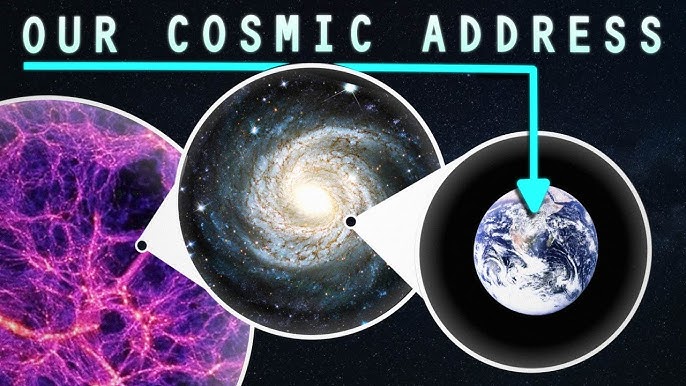Understanding Our Cosmic Address
Introduction
Astronomy is a fascinating field that explores the vastness of the universe, our place within it, and the intricate structures that comprise it. One of the most intriguing concepts in astronomy is our “cosmic address,” which describes the location of Earth in the universe. This article will provide a comprehensive overview of what our cosmic address entails, breaking down each component and its significance. We will also explore the implications of our cosmic location and how it shapes our understanding of the universe.
What is a Cosmic Address?
A cosmic address is a hierarchical system that identifies the location of Earth in the universe, similar to how a postal address identifies a specific location on Earth. Just as a postal address includes details like street name, city, and country, our cosmic address encompasses various astronomical structures, from our planet to the broader universe.
The Components of Our Cosmic Address
To understand our cosmic address, we need to break it down into its individual components:
- Earth: Our home planet, the only known celestial body to support life.
- Solar System: A collection of celestial bodies, including the Sun, eight planets (including Earth), their moons, and various smaller objects like asteroids and comets.
- Orion Arm: Also known as the Orion Spur, this is the minor spiral arm of the Milky Way galaxy where our solar system is located.
- Milky Way Galaxy: The galaxy that contains our solar system, composed of billions of stars, planets, and other celestial objects.
- Local Group: A collection of more than 54 galaxies, including the Milky Way, Andromeda, and several smaller dwarf galaxies.
- Virgo Supercluster: A massive group of galaxies that includes the Local Group and is one of the largest structures in the universe.
- Laniakea Supercluster: An even larger supercluster that encompasses the Virgo Supercluster and many other galaxy clusters, spanning over 520 million light-years.
- Observable Universe: The portion of the universe that we can observe from Earth, limited by the speed of light and the age of the universe.
- Universe: The entirety of space, time, matter, and energy, including all galaxies, stars, planets, and cosmic structures.
Our Complete Cosmic Address
Putting all these components together, our complete cosmic address can be summarized as follows:Earth, Solar System, Orion Arm, Milky Way Galaxy, Local Group, Virgo Supercluster, Laniakea Supercluster, Observable Universe, Universe.
The Significance of Our Cosmic Address
Understanding our cosmic address is crucial for several reasons:
- Perspective: It provides a humbling perspective on our place in the universe, reminding us that Earth is just one small part of a vast cosmic landscape.
- Scientific Exploration: Knowing our location helps astronomers and scientists study the universe’s structure, formation, and evolution.
- Astrobiology: Understanding our cosmic address can inform the search for extraterrestrial life by identifying potentially habitable zones in other solar systems.
- Cosmology: Our cosmic address is essential for understanding the universe’s expansion, the distribution of galaxies, and the overall structure of the cosmos.
The Scale of the Universe
To appreciate the enormity of our cosmic address, it’s essential to understand the scale of the universe:
- Earth: Approximately 12,742 km in diameter.
- Solar System: The solar system extends about 100 astronomical units (AU) from the Sun, where 1 AU is the average distance from the Earth to the Sun (about 93 million miles or 150 million kilometers).
- Milky Way Galaxy: The Milky Way is about 100,000 light-years in diameter and contains 100 to 400 billion stars.
- Local Group: The Local Group spans about 10 million light-years in diameter.
- Virgo Supercluster: The Virgo Supercluster has a diameter of about 110 million light-years.
- Laniakea Supercluster: This supercluster is approximately 520 million light-years wide.
- Observable Universe: The observable universe is about 93 billion light-years in diameter.
The Movement of Our Cosmic Address
It’s important to note that our cosmic address is not static; everything in the universe is in constant motion. The Earth orbits the Sun, the solar system moves through the Milky Way, and the Milky Way itself is part of the Local Group, which is moving toward the Virgo Supercluster. Additionally, the entire Laniakea Supercluster is moving through the universe.
The Future of Our Cosmic Address
As our understanding of the universe evolves, so too may our cosmic address. Ongoing research in astronomy and astrophysics continues to reveal new insights into the structure of the universe, the nature of dark matter and dark energy, and the potential for discovering new cosmic structures.
Conclusion
Our cosmic address provides a fascinating framework for understanding our place in the universe. By breaking down the components of our address, we gain insight into the vastness of space and the interconnectedness of celestial bodies. As we continue to explore the universe, our cosmic address serves as a reminder of the incredible scale and complexity of the cosmos.
FAQ Section
Q1: What is our cosmic address?A1: Our cosmic address is: Earth, Solar System, Orion Arm, Milky Way Galaxy, Local Group, Virgo Supercluster, Laniakea Supercluster, Observable Universe, Universe.
Q2: Why is understanding our cosmic address important?A2: Understanding our cosmic address provides perspective on our place in the universe, informs scientific exploration, aids in the search for extraterrestrial life, and contributes to cosmological studies.
Q3: How large is the observable universe?A3: The observable universe is approximately 93 billion light-years in diameter.
Q4: What is the Laniakea Supercluster?A4: The Laniakea Supercluster is a massive supercluster that encompasses the Virgo Supercluster and many other galaxy clusters, spanning over 520 million light-years.
Q5: How does our cosmic address change over time?A5: Our cosmic address changes over time due to the constant motion of celestial bodies, including the Earth’s orbit around the Sun, the solar system’s movement through the Milky Way, and the Milky Way’s movement within the Local Group and beyond.
Additional Resources
| Resource | Link |
|---|---|
| Cosmic Address Overview | Wikipedia |
This article provides a comprehensive overview of our cosmic address, exploring its components, significance, and the vastness of the universe. Understanding our place in the cosmos enriches our appreciation for the universe and inspires further exploration and discovery.
Read more about it:https://greyhoundsverdevalley.com/what-is-a-jive-turkey/



